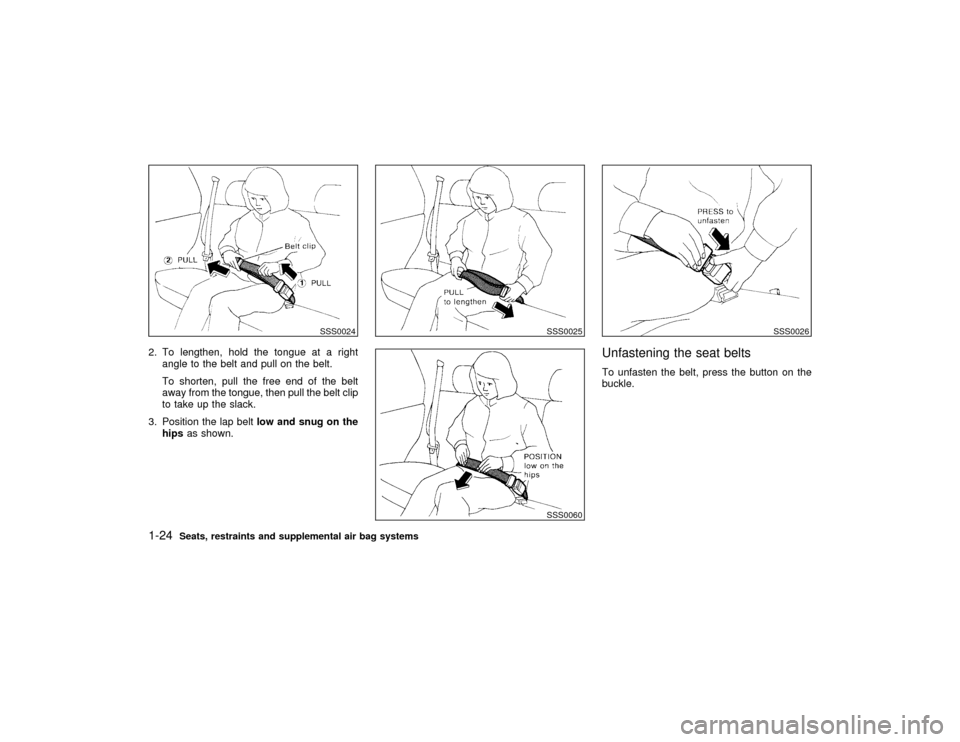1998 NISSAN PATHFINDER length
[x] Cancel search: lengthPage 31 of 249

2. To lengthen, hold the tongue at a right
angle to the belt and pull on the belt.
To shorten, pull the free end of the belt
away from the tongue, then pull the belt clip
to take up the slack.
3. Position the lap beltlow and snug on the
hipsas shown.
Unfastening the seat beltsTo unfasten the belt, press the button on the
buckle.
SSS0024
SSS0025SSS0060
SSS0026
1-24
Seats, restraints and supplemental air bag systems
Z
01.1.31/R50-D
X
Page 32 of 249

SEAT BELT EXTENDERSIf, because of body size or driving position, it is
not possible to properly fit the lap-shoulder belt
and fasten it, an extender is available which is
compatible with the installed seat belts. The
extender adds approximately 8 inches (200
mm) of length and may be used for either the
driver or right passenger seating position. See
your NISSAN dealer for assistance if the ex-
tender is required.IOnly NISSAN belt extenders, made by
the same company which made the
original equipment belts, should be
used with NISSAN belts.
IPersons who can use the standard
seat belt should not use an extender.
Such unnecessary use could result in
serious personal injury in the event of
an accident.
SEAT BELT MAINTENANCEITo clean the seat belt webbings,apply a
mild soap solution or any solution recom-
mended for cleaning upholstery or carpets.
Then brush the webbing, wipe it with a cloth
and allow it to dry in the shade. Do not allow
the seat belts to retract until they are com-
pletely dry.
IIf dirt builds up in the shoulder belt guide of
the seat belt anchors, the seat belts may
retract slowly. Wipe the shoulder belt guide
with a clean, dry cloth.
IPeriodically check to see that the seat
belt and the metal componentssuch as
buckles, tongues, retractors, flexible wires
and anchors work properly. If loose parts,
deterioration, cuts or other damage on the
webbing is found, the entire belt assembly
should be replaced.
PRECAUTIONS ON CHILD
RESTRAINTSIInfants and small children should al-
ways be placed in an appropriate
child restraint while riding in the ve-
hicle. Failure to use a child restraint
can result in serious injury or death.
IInfants and small children should
never be carried on your lap. It is not
possible for even the strongest adult
to resist the forces of a severe acci-
dent. The child could be crushed be-
tween the adult and parts of the ve-
hicle. Also, do not put the same seat
belt around both your child and your-
self.
INever install a rear facing child re-
straint in the front seat. An inflating
supplemental air bag could seriously
injure or kill your child. A rear facing
child restraint must only be used in
the rear seat.
INissan recommends that the child
restraint be installed in the rear seat.CHILD RESTRAINTS
Seats, restraints and supplemental air bag systems
1-25
Z
01.1.31/R50-D
X
Page 42 of 249

Bolt diameter: 8.0 mm
Bolt length: more than 1.18 in (30 mm)
Thread pitch: 1.25 mm
Secure the top strap to the attaching bolt which
provides the straightest installation of the top
strap.Child restraint anchor points are de-
signed to withstand only those loads
imposed by correctly fitted child re-
straints. Under no circumstances are
they to be used for adult seat belts or
harnesses.
Anchor point locationsAnchor point attaching bolts are located under
the carpet of the rear luggage area floor.
Your NISSAN dealer can assist you with the
installation of your child restraint.The anchor bolt should be installed at all
times to prevent the possibility of ex-
haust fumes entering the passenger
compartment through the holes. See
ªPrecautions when starting and drivingºin the ª5. Starting and drivingº section
for exhaust gas.
SPA0393Seats, restraints and supplemental air bag systems
1-35
Z
01.1.31/R50-D
X
Page 118 of 249

Do not force the cassette tape into the
tape door. This could cause player
damage.The cassette tape automatically changes di-
rections to play the other side when the first
side is complete. At this time, the moving
digital squares illuminate on the left side of the
display window.
Precaution on cassette player operation:
ITo maintain good quality sound, NISSAN
recommends using cassette tapes of 60
minutes or shorter in length.
ICassette tapes should be removed from the
player when not in use. Store cassettes in
their protective cases and away from direct
sunlight, heat, moisture and magnetic
sources.
IDirect sunlight can cause the cassette to
become deformed. The use of deformed
cassettes may cause the cassette to jam in
the player.
IDo not use cassettes with labels which are
peeling and loose. If used, the label could
jam in the player.IIf a cassette has loose tape, insert a pencil
through one of the cassette hubs and re-
wind the tape firmly around the hubs. Loose
tape may cause tape jamming and waver-
ing sound quality.
IOver a period of time, the playback head,
capstan and pinch roller may collect a tape
coating residue as the tape is played. This
residue accumulation can cause weak or
wavering sound, and should be removed
periodically with a head cleaning tape. If the
residue is not removed periodically, the
player may need to be disassembled for
cleaning.
PLAY/STOP:
Push the
button while the cassette tape
is playing to stop the tape. Push the button
again to play the tape.
FF (fast forward), REW
(rewind):
Push either the
or
button for the
desired direction.
The FF or REW symbol illuminates in the
display.
To stop the FF or REW function, press the
or
again, or the
button.
APS (automatic program
search) FF, APS REW:
Push either theor
button while the
cassette tape is playing. The tape runs quickly,
stops, then plays the next selection. Either the
FF or REW symbol flashes in the display while
searching for the selection.
This system searches at the blank intervals
between selections. If there is a blank interval
within one selection or there is no interval
between selections, the system may not stop
in the desired or expected location.
PROG (program):
Push the
(program) select button. The
moving digital squares illuminate on either the
right or left side of the display window to
indicate the side of program play.
Dolby NR (noise reduction):
Push the
button for Dolby NR encoded
tapes to reduce high frequency tape noise.
The
indicator light comes on.
If in the clock display is in priority mode when
thebutton is pressed,
and TAPE
illuminate in the display window for about 10
seconds. The clock mode then returns to the
display window.
Dolby NR is manufactured under license from
Heater, air conditioner and audio systems
4-17
Z
01.1.31/R50-D
X
Page 123 of 249

1. Tune to the desired station.
2. Push the desired select button for more
than 1.5 seconds. (For example, in the
diagram ch2 is to be memorized. The radio
mutes when the select button is pushed.)
3. The indicator ch2 will then come on and the
sound will resume. Memorizing is now com-
plete.
4. Other buttons can be set in the same
manner.
If the battery cable is disconnected, or if the
fuse blows, the radio memory will be can-
celled. In that case, reset the desired stations.Cassette tape player operationTurn the ignition key to ACC or ON, and then
lightly insert the cassette tape into the tape
door. The cassette tape will be automatically
pulled into the player.
The radio or CD will turn off (if it is on) and the
cassette tape will begin to play.
Do not force the cassette tape into the
tape door.
This could cause player damage.If the system is turned off by pushing the
Power/Volume control knob with the cassette
tape still in the player, the tape will resume
playing when the Power/Volume control knob
is pushed again.
Precautions on cassette player operation:
ITo maintain good quality sound,
NISSAN recommends that you use cas-
sette tapes of 60 minutes or shorter in
length.
ICassette tapes should be removed from
the player when not in use. Store cas-
settes in their protective cases and away
from direct sunlight, heat, moisture or
magnetic sources.
Direct sunlight can cause the cassette to
become deformed. The use of deformed
cassettes may cause the cassette to jam
in the player.
IDo not use cassettes that have peelingor loose labels. If used, the label could
jam in the player.
IIf a cassette has loose tape, insert a
pencil through one of the cassette hubs
and rewind the tape firmly. Loose tape
may cause jamming and wavering
sound quality.
IOver a period of time, the playback
head, capstan and pinch roller may
gather a tape coating residue as the tape
passes over the head. This residue ac-
cumulation can cause a weak or waver-
ing sound and should be removed peri-
odically with a head cleaning tape.
If the residue is not removed periodi-
cally, the player may need to be disas-
sembled for cleaning.
PLAY/STOP:
IWhen this button is pushed with the system
turned off and a tape loaded, the system
will come on and the tape will play.
IWhen this button is pushed with either the
radio or compact disc turned on and the
tape loaded, the compact disc or the radio
will automatically be turned off and the tape
will play.
While the tape is playing, pushing the TAPE
4-22
Heater, air conditioner and audio systems
Z
01.1.31/R50-D
X
Page 129 of 249

IDo not leave children, unreliable
adults, or pets alone in your vehicle.
They could accidentally injure them-
selves or others through inadvertent
operation of the vehicle. Also, on hot,
sunny days, temperatures in a closed
vehicle could quickly become high
enough to cause severe or possibly
fatal injuries to people or animals.
IProperly secure all cargo to help pre-
vent it from sliding or shifting. Do not
place cargo higher than the seat-
backs. In a sudden stop or collision,
unsecured cargo could cause per-
sonal injury.
EXHAUST GAS (Carbon monoxide)Do not breathe exhaust gases; they con-
tain colorless and odorless carbon mon-
oxide. Carbon monoxide is a dangerous.
It can cause unconsciousness or death.
IIf you suspect that exhaust fumes are
entering the vehicle, drive with all
windows fully open, and have the
vehicle inspected immediately.
IDo not run the engine in closed
spaces such as a garage.
IDo not park the vehicle with the en-
gine running for any extended length
of time.
IKeep the back door and rear window
closed while driving, otherwise ex-
haust gases could be drawn into the
passenger compartment. If you must
drive with the back door on rear win-
dow open, follow these precautions:
1. Open all the windows.
2. Set the air recirculation switchOFF and the fan control at 4 (high)
to circulate the air.
IIf electrical wiring or other cable con-
nections must pass to a trailer
through the seal on the back door or
the body, follow the manufacturer's
recommendation to prevent carbon
monoxide entry into the vehicle.
IIf a special body or other equipment
is added for recreational or other us-
age, follow the manufacturer's rec-
ommendation to prevent carbon
monoxide entry into the vehicle.
(Some recreational vehicle appli-
ances such as stoves, refrigerator,
heaters, etc. may also generate car-
bon monoxide.)
IThe exhaust system and body should
be inspected by a qualified mechanic
whenever:
a. The vehicle is raised for service.
b. You suspect that exhaust fumes
are entering into the passenger
compartment.
c. You notice a change in the sound
PRECAUTIONS WHEN STARTING
AND DRIVING5-2
Starting and driving
Z
01.1.31/R50-D
X
Page 228 of 249

ENGINE
Model VG33E
Type Gasoline, 4-cycle
Cylinder arrangement 6-cylinder, V-slanted at 60É
Bore´Stroke in (mm) 3.602´3.268 (91.5´83.0)
Displacement
cu in (cm
3)199.84 (3,275)
Firing order 1-2-3-4-5-6*1
Idle speed rpm
See the ªEmission control
labelº on the underside of the
hood. Ignition timing (BTDC)
degree/rpm
CO percentage at idle speed
[No air] %
Spark plug BKR4E-11 (Hot)
BKR5E-11 (Standard)
BKR6E-11 (Cold)
Spark plug gap in (mm) 0.039 to 0.043 (1.0 to 1.1)
Camshaft operation Timing belt*2
Alternator belt size
Width´Length
in (mm)0.8409´41.93 (21.36´1,065)
*2: Periodic maintenance is necessary. See ªPeriodic maintenanceº in the ª9.
Maintenanceº section for maintenance intervals.
The spark ignition system of this vehicle meets all requirements of
the Canadian Interference-Causing Equipment Regulations.
TI0001-A
SPECIFICATIONS
Technical and consumer information
10-9
Z
01.1.31/R50-D
X
Page 230 of 249

DIMENSIONS AND WEIGHTSPATHFINDER
Overall length*1 in (mm) 178.3 (4,530)
Overall width in (mm) 68.7 (1,745)
72.4 (1,840)*2*3
Overall height in (mm) 67.1 (1,705)
67.9 (1,725)*2
Front tread in (mm) 58.3 (1,480)
59.1 (1,500)*2
Rear tread in (mm) 58.5 (1,485)
59.3 (1,505)*2
Wheelbase in (mm) 106.3 (2,700)
Gross vehicle weight rating
lb (kg)See the ªF.M.V.S.S. certification
labelº on the driver's side lock
pillar.
Gross axle weight rating
Front lb (kg)
Rear lb (kg)
*1: On spare tire carrier equipped models, the spare tire carrier adds 9.45 in (240
mm) to the overall length.
*2: SE models
*3: XE models with overfender
When planning to travel in another country,
you should first find out if the fuel available is
suitable for your vehicle's engine.
Using fuel with too low an octane rating
may cause engine damage. All gasoline
vehicles can be operated with unleaded
gasoline. Therefore, avoid taking your ve-
hicle to areas where appropriate fuel is not
available.
When transferring the registration of your
vehicle to another country, state, province
or district,it may be necessary to modify the
vehicle to meet local laws and regulations.
The laws and regulations for motor vehicle
emission control and safety standards vary
according to the country, state, province or
district; therefore, vehicle specifications may
differ.
When any vehicle is to be taken into an-
other country, state, province or district
and registered, its modifications, transpor-
tation and registration are the responsibil-
ity of the user. NISSAN is not responsible
for any inconvenience that may result.WHEN TRAVELING OR
REGISTERING YOUR VEHICLE IN
ANOTHER COUNTRYTechnical and consumer information
10-11
Z
01.1.31/R50-D
X